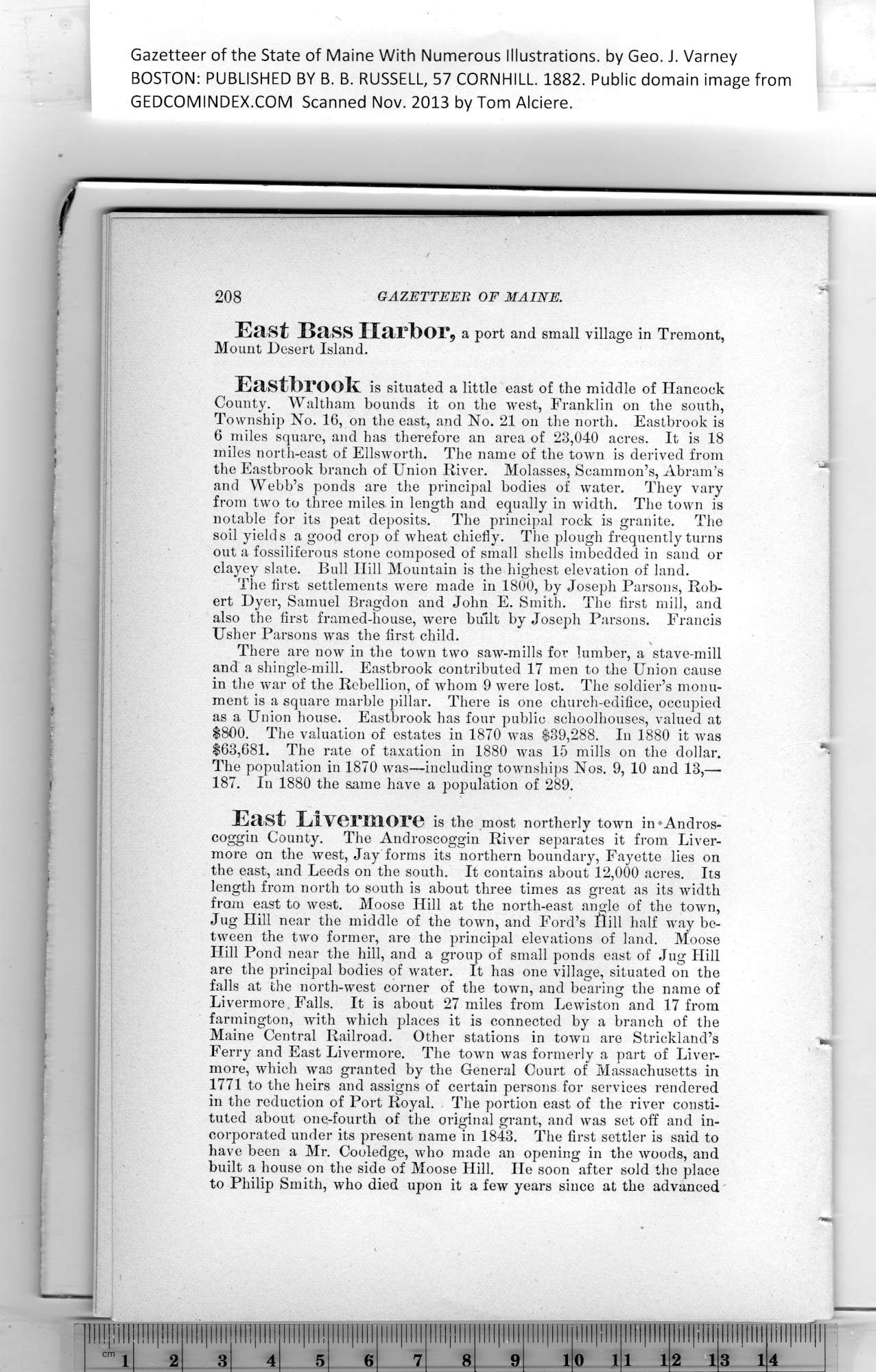|
Gazetteer of the State of Maine With Numerous Illustrations, by Geo. J. Varney
BOSTON: PUBLISHED BY B. B. RUSSELL, 57 CORNHILL. 1882. Public domain image from
208 GAZETTEER OF MAINE.
East Bass Harbor, a port and small village in Tremont,
Mount Desert Island.
Eastbrook is situated a little east of the middle of Hancock
County. Waltham bounds it on the west, Franklin on the south,
Township No. 16, on the east, and No. 21 on the north. Eastbrook is
6 miles square, and has therefore an area of 23,040 acres. It is 18
miles north-east of Ellsworth. The name of the town is derived from
the Eastbrook branch of Union River. Molasses, Scammon’s, Abram’s
and Webb’s ponds are the principal bodies of water. They vary
from two to three miles in length and equally in width. The town is
notable for its peat deposits. The principal rock is granite. The
soil yields a good crop of wheat chiefly. The plough frequently turns
out a fossiliferous stone composed of small shells imbedded in sand or
clayey slate. Bull Hill Mountain is the highest elevation of land.
The first settlements were made in 1800, by Joseph Parsons, Rob-
ert Dyer, Samuel Bragdon and John E. Smith. The first mill, and
also the first framed-house, were built by Joseph Parsons. Francis
Usher Parsons was the first child.
There are now in the town two saw-mills for lumber, a stave-mill
and a shingle-mill. Eastbrook contributed 17 men to the Union cause
in the war of the Rebellion, of whom 9 were lost. The soldier’s monu-
ment is a square marble pillar. There is one church-edifice, occupied
as a Union house. Eastbrook has four public schoolhouses, valued at
$800. The valuation of estates in 1870 was $39,288. In 1880 it was
$63,681. The rate of taxation in 1880 was 15 mills on the dollar.
The population in 1870 was—including townships Nos. 9, 10 and 13,—
187. In 1880 the same have a population of 289.
East Livermore is the most northerly town in'Andros-
coggin County. The Androscoggin River separates it from Liver-
more on the west, Jay forms its northern boundary, Fayette lies on
the east, and Leeds on the south. It contains about 12,000 acres. Its
length from north to south is about three times as great as its width
from east to west. Moose Hill at the north-east angle of the town,
Jug Hill near the middle of the town, and Ford’s Bill half way be-
tween the two former, are the principal elevations of land. Moose
Hill Pond near the hill, and a group of small ponds east of Jug Hill
are the principal bodies of water. It has one village, situated on the
falls at the north-west corner of the town, and bearing the name of
Livermore, Falls. It is about 27 miles from Lewiston and 17 from
farmington, with which places it is connected by a branch of the
Maine Central Railroad. Other stations in town are Strickland’s
Ferry and East Livermore. The town was formerly a part of Liver-
more, which was granted hy the General Court of Massachusetts in
1771 to the heirs and assigns of certain persons for services rendered
in the reduction of Port Royal. The portion east of the river consti-
tuted about one-fourth of the original grant, and was set off and in-
corporated under its present name in 1843. The first settler is said to
have been a Mr. Cooledge, who made an opening in the woods, and
built a house on the side of Moose Hill. He soon after sold the place
to Philip Smith, who died upon it a few years since at the advanced
PREVIOUS PAGE ... NEXT PAGE
This page was written in HTML using a program written in Python 3.2
|
